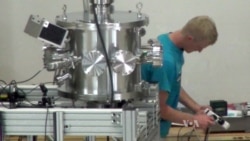Our Milky Way solar system began as small pieces of star-created gas and dust. They came together to form the Sun, the Earth and other planets, and life as we know it. But not all the dust was used, and what remains can be dangerous.
Scientists are studying this dust with a student-designed instrument on the American space agency’s New Horizons spacecraft. The agency is busy collecting information from the spacecraft this week in the first-ever flyby of Pluto.
David James is a research assistant at the University of Colorado. Our reporter found him in one of the university’s laboratories on a recent day. He was inspecting the settings on a room-size machine.
“That’s one of the cryopumps. You have to continuously pull air out otherwise it will leak up to the atmosphere again”
Those pumps take air from a tunnel or passageway. The process helps scientists make dust on Earth move as fast as it would in space.
“We’ve even reached 107 kilometers per second is our fastest particle here.”
The tests may help scientists learn what causes dust to be created in space. It may also help them design spacecraft and equipment that cannot be hurt by dust.
David James says he became interested in space more than 10 years ago when he was studying physics in graduate school. A friend told him about the Student Dust Counter project.
“She said ‘I’m working on this project that’s really neat. It has a lot of real-world applications and, you know, it’s eventually going to be launched into space.’”
Tiffany Finley was also a graduate student when she began working on the dust counter project, in 2002.
“This opportunity came up and I said ‘What? You’re going to Pluto? I would love to be part of that.’”
The dust counter was designed to measure and count the dust that hit and flew by the New Horizons spacecraft as it traveled to Pluto. Tiffany Finley says such a device would usually be created by experts.
“As a student project, it’s one of the first where students actually got to build the hardware on the mission.”
She later became the manager of the dust project. Today, Ms. Finley is the Science Operations Manager for the New Horizons mission.
Mihaly Horanyi is a professor of physics at the University of Colorado. He also serves as the faculty advisor for the Student Dust Counter project. He says the counter did not cost as much money as it would have if a company built it because so many students were involved. More than 30 students have worked on the project.
The Student Dust Counter was launched with the New Horizons spacecraft in 2006. Six devices on the almost 5-billion-kilometer-long journey were designed to stay quiet during the trip. Now they are operating. They are sending color pictures back to Earth, and studying Pluto’s chemical makeup. But the Student Dust Counter has been operating throughout the trip.
Professor Horanyi says dust counters help researchers better understand space dust, including the problems it may cause for space travelers. Even the smallest particles of dust can be harmful.
“Hundred-micron-size particles, like that thickness of your hair, if they were to hit the spacecraft at 10, 15 kilometers per sec(ond), that’s an end of mission event. It’s over. It would puncture a hole. It would destroy the mission.”
After a planned five-month-long exploration of Pluto, most scientific instruments on New Horizon will stop operating. But the spacecraft itself will continue flying past the edge of our solar system, and the Student Dust Counter will keep on counting.
I’m Jim Tedder.
Shelley Schlender reported this story from Boulder, Colorado. Christopher Jones-Cruise adapted it for Learning English. George Grow was the editor.
______________________________________________________________
Words in This Story
solar system – n. the sun and everything that moves around it
neat – (informal) adj. pleasant, fun or interesting
real-world application(s) – n. something that can be used in life rather than only in theory or in a laboratory
hardware – n. computer equipment
sec(ond) – n. a unit of time that is equal to 1/60th of a minute
puncture – v. to make a hole in (something) with a sharp point
Are students in your country working on space projects? We want to hear from you. Write your thoughts in the comments section.






